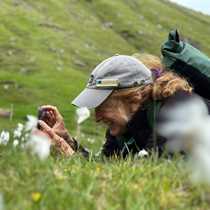A ponderosa pine amongst the Sitka spruce and western red cedars. This particular pine is a re-creation of a dugout canoe made and used by the Lewis and Clark Expedition. When the Corps of Discovery was once again ready to take to the water after crossing the Bitterroots , they cut ponderosa pines from the shores of the Clearwater. The expedition was not in good shape when they established Canoe Camp. The foods they were given by the Nez Perce Indians, dried salmon and camas roots, were a drastic change to their digestive systems. The journals note for several consecutive days "...several 8 or 9 men sick, Capt. Lewis sick and complain of a Lax & heaviness at the stomack..." the cure was no better than the ailment, a dose of Rush's pills a.k.a. "Rush's Thunderbolts." A few days later Captain Lewis and others were still not doing well and Clark administered "...Salts Pils Galip, Tarter emetic &c." and added "I feel unwell this evening"
The more refined canoe shown is an example of the coastal canoes, usually made from western red cedar. These were handsome craft usually embellished with animal images on the bow. The size of the biggest canoes, 60 feet by 8 feet, enabled the coastal tribes to easily navigate the Northwest waters.
The party obtained two of these canoes before starting their eastern return. One canoe was obtained by trade and another was procured by more larcenous means. On March 18th it was noted that four men went "over to the prarie near the coast" and took a canoe, "as we are in want of it."
In comparison, our last six days on the Sea Lion have been most comfortable as we explored the Columbia and Snake Rivers. The crew and their attention to detail have made a trip in the "Wake of Lewis and Clark" interesting, informative and most of all, memorable.




